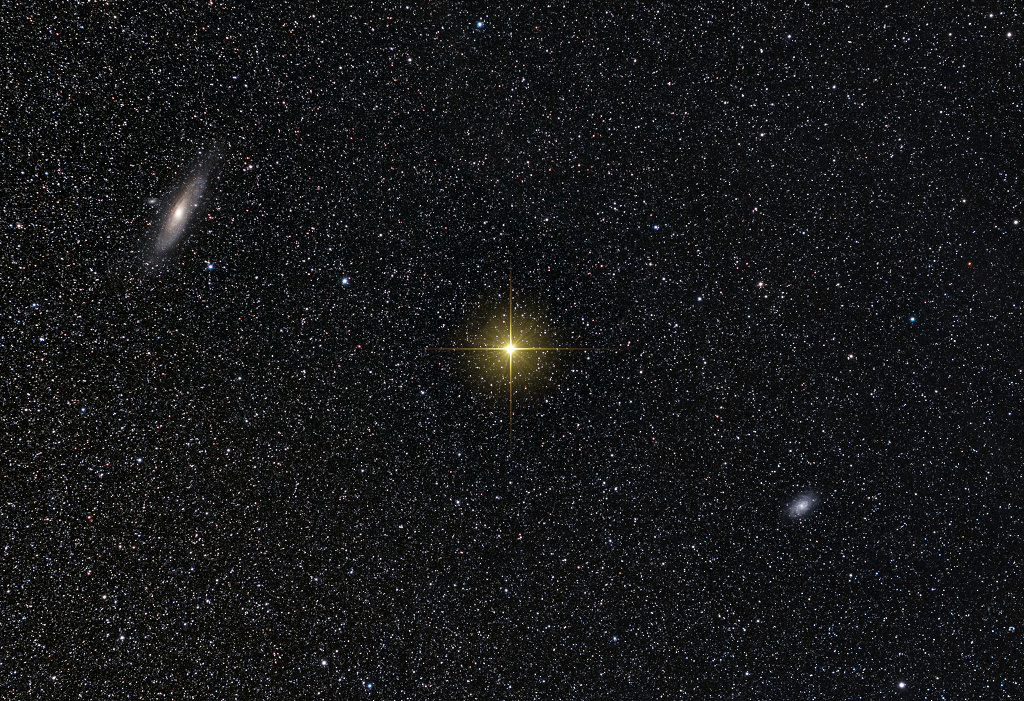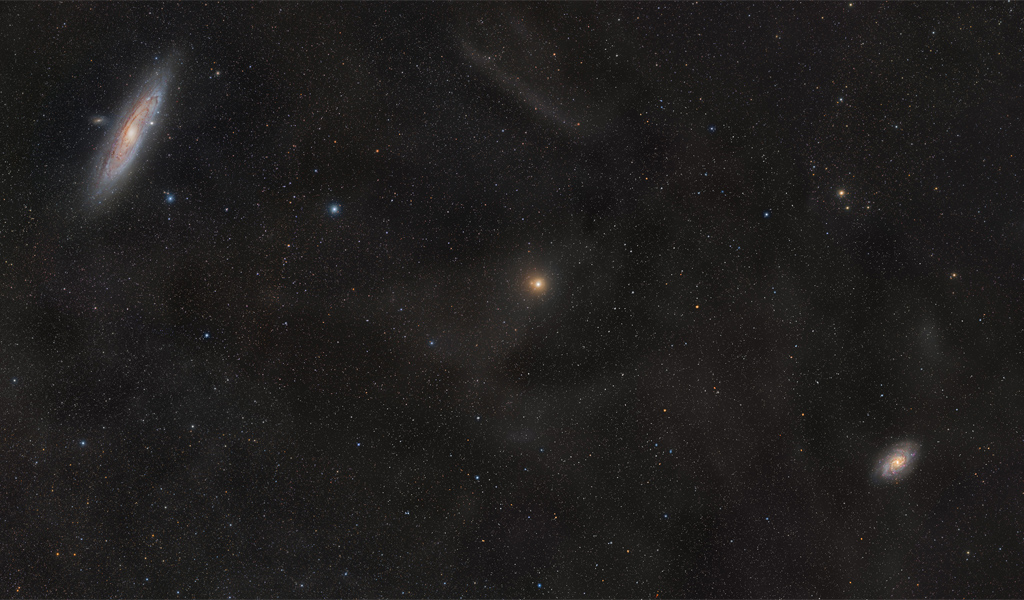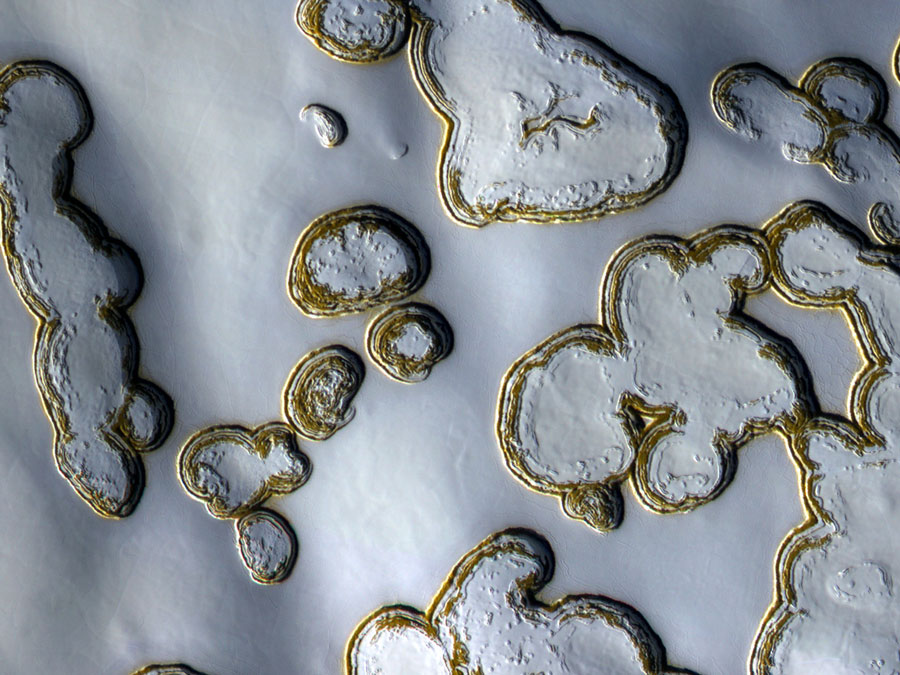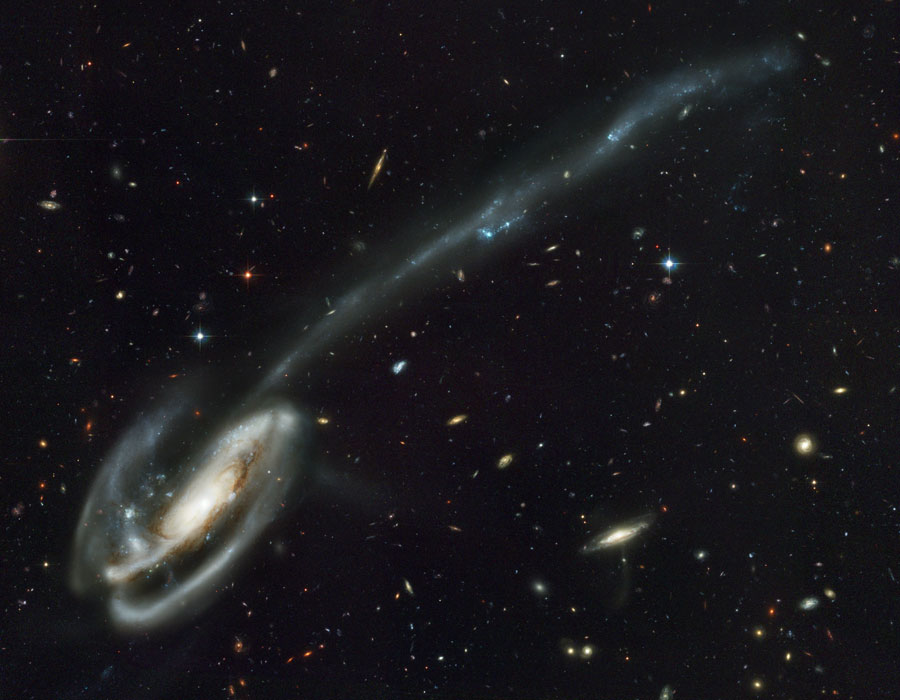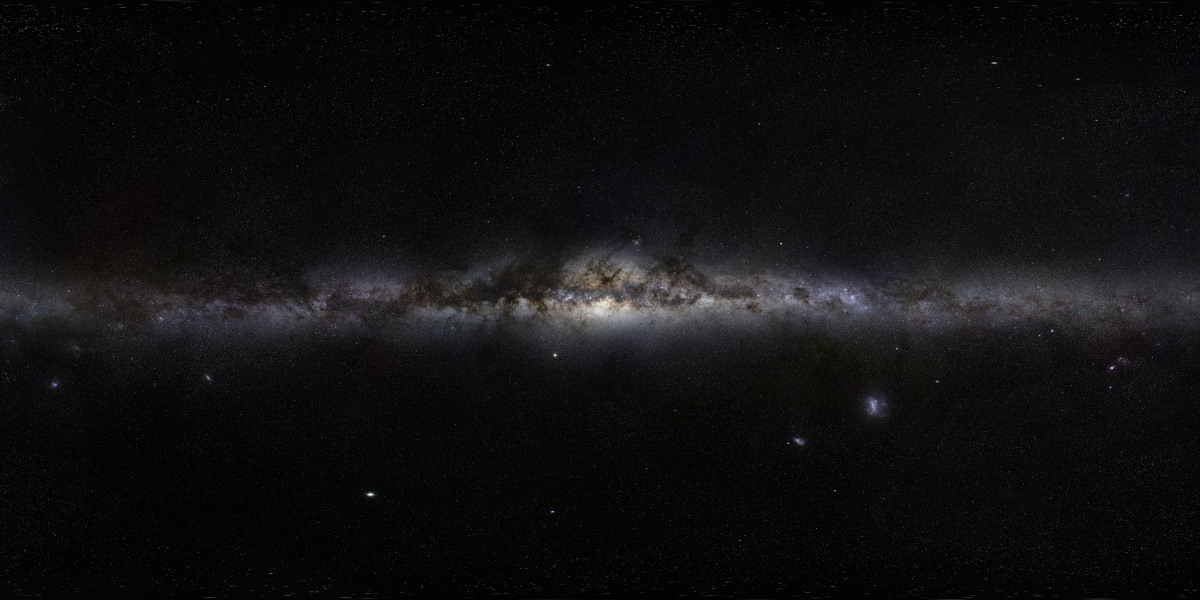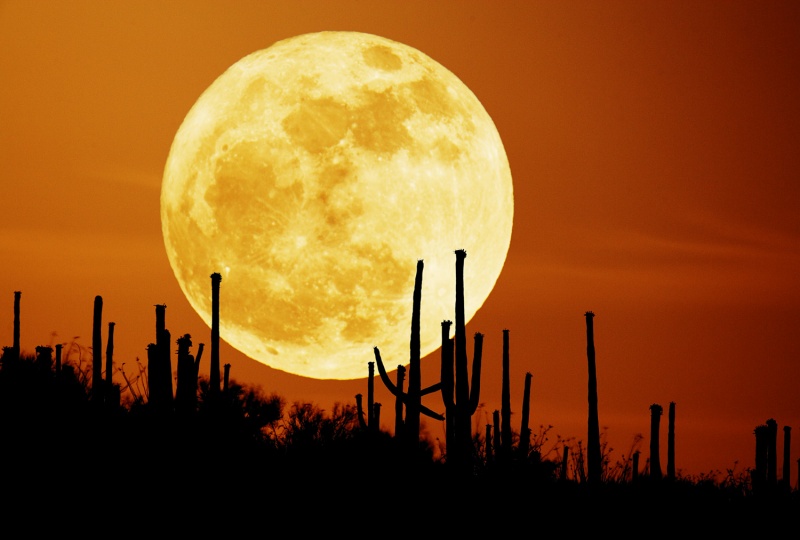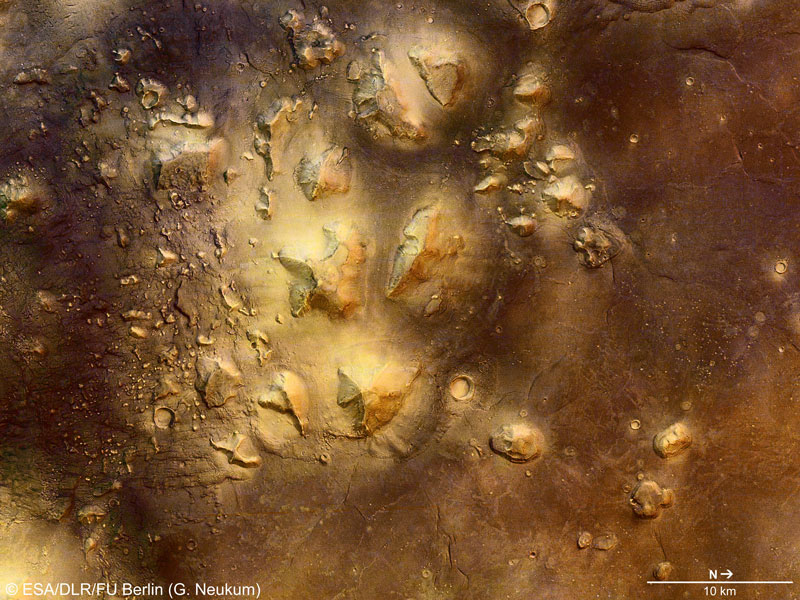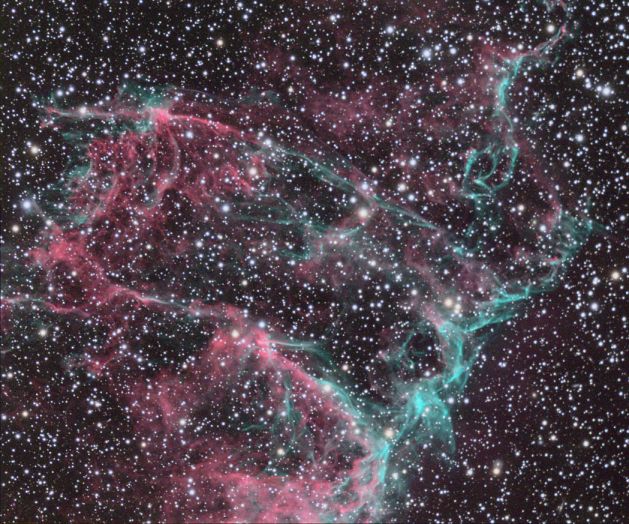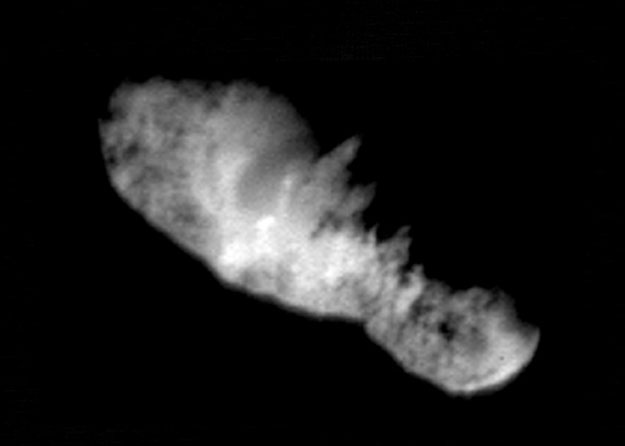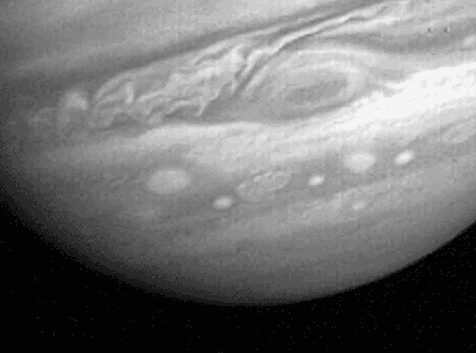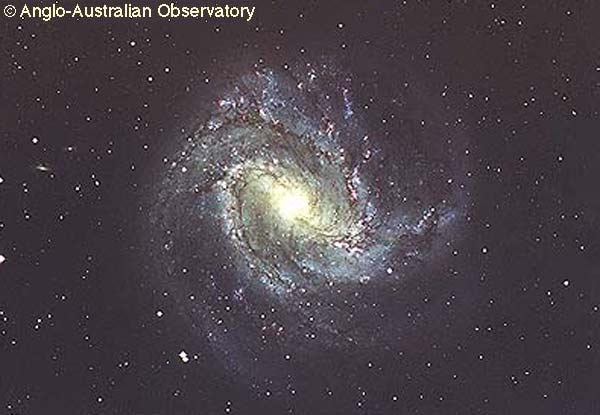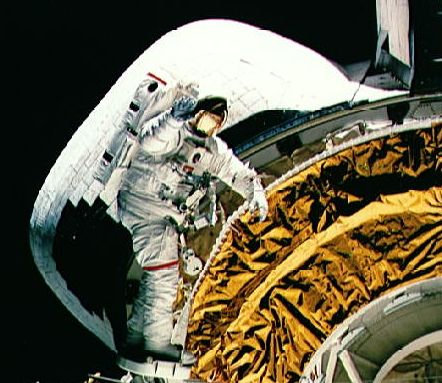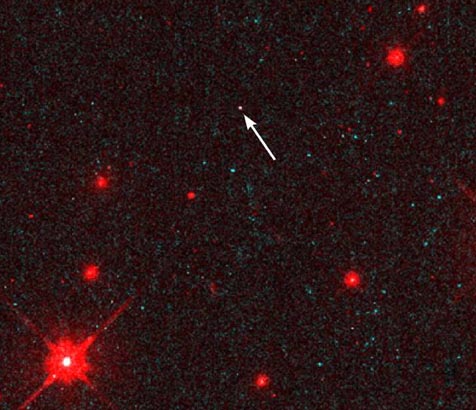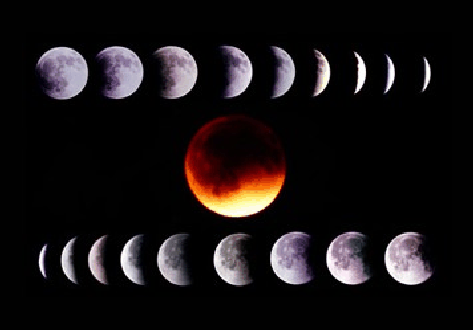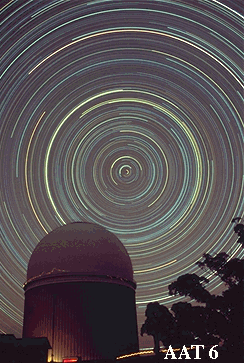| << Previous | Index | Next >> |
2015 Separated by about 14 degrees (28 Full Moons) in planet Earth's sky, spiral galaxies M31 at left, and M33 are both large members of the Local Group, along with our own Milky Way galaxy. This narrow- and wide-angle, multi-camera composite finds details of spiral structure in both, while the massive neighboring galaxies seem to be balanced in starry fields either side of bright Mirach, beta star in the constellation Andromeda. Mirach is just 200 light-years from the Sun. But M31, the Andromeda Galaxy, is really 2.5 million light-years distant and M33, the Triangulum Galaxy, is also about 3 million light years away. Although they look far apart, M31 and M33 are engaged in a gravitational struggle. In fact, radio astronomers have found indications of a bridge of neutral hydrogen gas that could connect the two, evidence of a closer encounter in the past. Based on measurements, gravitational simulations currently predict that the Milky Way, M31, and M33 will all undergo mutual close encounters and potentially mergers, billions of years in the future.
2014 Launched on November 18, 2013, the MAVEN (Mars Atmosphere and Volatile EvolutioN) spacecraft completed its interplanetary voyage September 21, captured into a wide, elliptical orbit around Mars. MAVEN's imaging ultraviolet spectrograph has already begun its planned exploration of the Red Planet's upper atmosphere, acquiring this image data from an altitude of 36,500 kilometers. In false color, the three ultraviolet wavelength bands show light reflected from atomic hydrogen (in blue), atomic oxygen (in green) and the planet's surface (in red). Low mass atomic hydrogen is seen to extend thousands of kilometers into space, with the cloud of more massive oxygen atoms held closer by Mars' gravity. Both are by products of the breakdown of water and carbon dioxide in Mars' atmosphere and the MAVEN data can be used to determine the rate of water loss over time. In fact, MAVEN is the first mission dedicated to exploring Mars' tenuous upper atmosphere, ionosphere and interactions with the Sun and solar wind. But the most recent addition to the fleet of spacecraft from planet Earth now in martian orbit is MOM.
2013 Separated by about 14 degrees (28 Full Moons) in planet Earth's sky, spiral galaxies M31, left, and M33 are both large members of the Local Group, along with our own Milky Way galaxy. This wide-angle, telescopic mosaic captures colorful details of spiral structure in both, while the massive neighboring galaxies seem to be balanced either side of bright Mirach, beta star in the constellation Andromeda. But M31, the Andromeda Galaxy, is really 2.5 million light-years distant and M33, the Triangulum Galaxy, is also about 3 million light years away. Mirach, just 200 light-years from the Sun, lies well within the Milky Way, along with the dim clouds of dust drifting through the frame only a few hundred light-years above the galactic plane. Although they look far apart, M31 and M33 are locked in a mutual gravitational embrace. Radio astronomers have found indications of a bridge of neutral hydrogen gas that could connect the two, evidence of a closer encounter in the past. Based on measurements, gravitational simulations currently predict that the Milky Way, M31, and M33 will all undergo mutual close encounters and potentially mergers, billions of years in the future.
2012 It's not every day that a space shuttle lands at LAX. Although this was a first for the major Los Angeles airport hub, it was a last for the space shuttle Endeavour, as it completed its tour of California skies and landed, albeit atop a 747, for the last time. During its last flight the iconic shuttle and its chase planes were photographed near several of California's own icons including the Golden Gate Bridge in San Francisco, the Hollywood Sign, and the skyline of Los Angeles. Previously, in May, the space shuttle Enterprise was captured passing behind several of New York City's icons on its way to the Intrepid Sea, Air, & Space Museum. Pictured above, the piggybacking shuttle was snapped on approach last week to LAX as it crossed above and beyond a major Los Angeles street. Now retired, the space shuttles are all museum pieces, with the above shuttle scheduled to be towed along the streets of LA to the California Science Center.
2011 Part of Mars is defrosting. Around the South Pole of Mars, toward the end of every Martian summer, the warm weather causes a section of the vast carbon-dioxide ice cap to evaporate. Pits begin to appear and expand where the carbon dioxide dry ice sublimates directly into gas. These ice sheet pits may appear to be lined with gold, but the precise composition of the dust that highlights the pit walls actually remains unknown. The circular depressions toward the image center measure about 60 meters across. The HiRISE camera aboard the Mars-orbiting Mars Reconnaissance Orbiter captured the above image in late July. In the next few months, as Mars continues its journey around the Sun, colder seasons will prevail, and the thin air will turn chilly enough not only to stop the defrosting but once again freeze out more layers of solid carbon dioxide.
2010
2009 Our magnificent Milky Way Galaxy sprawls across this ambitious all-sky panorama. In fact, at 800 million pixels the full resolution mosaic strives to show all the stars the eye can see in planet Earth's night sky. Part of ESO's Gigagalaxy Zoom Project, the mosaicked images were recorded over several months of 2008 and 2009 at exceptional astronomical sites; the Atacama Desert in the southern hemisphere and the Canary Islands in the northern hemisphere. Also capturing bright planets and even a comet, the individual frames were stitched together and mapped into a single, flat, apparently seamless 360 by 180 degree view. The final result is oriented so the plane of our galaxy runs horizontally through the middle with the bulging Galactic Center at image center. Below and right of center are the Milky Way's satellite galaxies, the Magellanic Clouds.
2008 On September 7th, the first quarter Moon and passing clouds contributed to a dramatic night sky over the Byurakan Astrophysical Observatory. This panoramic view begins at the left looking toward the eastern horizon and the rising stars of the constellation Perseus. Sweeping your gaze to the right (south), you'll find the large observatory dome, housing a 2.6 meter diameter telescope, backlit by lights from nearby Yerevan, capital city of Armenia. Fittingly poised above the observatory dome is the bright, giant star Enif in the high-flying constellation Pegasus. Farther to the right, the brightest celestial beacon just above the clouds is our Solar System's ruling gas giant Jupiter. At the far right, the Moon is nearly hidden by an approaching cloudbank, but the clouds themselves actually cast shadows in the bright moonlight, creating the effect of Moon rays across the evening sky.
2007 A Full Moon rising can be a dramatic celestial sight, and Full Moons can have many names. For example, tonight's Full Moon, the one nearest the autumnal equinox in the northern hemisphere, is popularly called the Harvest Moon. According to lore the name is a fitting one because farmers could work late into the night at the end of the growing season harvesting crops by moonlight. In the same traditions, the Full Moon following the Harvest Moon is the Hunter's Moon. But, recorded on a trip to the American southwest, this contribution to compelling images of moonrise is appropriately titled Saguaro Moon.
2006 The unusual stone mesas of the Cydonia region on Mars are quite striking in appearance. Last week, the Mars Express project released a new close-up image of a portion of the Cydonia region on Mars. This new image, taken by the robotic Mars Express spacecraft now orbiting Mars, shows an area about 90 kilometers wide. In the far lower right of the above image, a particularly picturesque mesa can be seen as the upper right of the two mesas visible there. This mesa, when lit from just the right sun angle, can appear similar to a human face and became famous as the Face on Mars in 1976 Viking orbiter images. Better images show it to be just an interesting mesa. Such complex looking landforms in the Cydonia region are thought to be the result of landslides and erosion of the ancient Martian crust.
2005 How do huge clusters of galaxies evolve? To help find out, astronomers pointed the wide-angle Burrell-Schmidt telescope on Kitt Peak National Observatory in Arizona, USA at the nearby Virgo Cluster of Galaxies. After hundreds of 15-minute exposures taken over two months in early 2004, the result is a dramatically deep and wide angle image of Virgo, the closest cluster of galaxies to our Milky Way Galaxy. Bright foreground stars have been digitally removed from the image but are still represented by numerous unusual dark spots. Inspection of the above image shows unusually large halos for the brightest galaxies as well as unusual faint streams of stars connecting Virgo galaxies that previously appeared unrelated. The above image allows a better reconstruction of the past few billion years of the gigantic Virgo cluster and illuminates the dynamics of clusters of galaxies in general.
2004 Here is what the Earth looks like during a solar eclipse. The shadow of the Moon can be seen darkening part of Earth. This shadow moved across the Earth at nearly 2000 kilometers per hour. Only observers near the center of the dark circle see a total solar eclipse - others see a partial eclipse where only part of the Sun appears blocked by the Moon. This spectacular picture of the 1999 August 11 solar eclipse was one of the last ever taken from the Mir space station, which was deorbited in a controlled re-entry in 2001.
2003 These ghostly filaments of interstellar gas are just a small part of the expansive Veil Nebula, seen against a rich field of background stars in the long-necked constellation Cygnus. Also known as the Cygnus Loop, the Veil Nebula is a supernova remnant, the expanding debris cloud created by a stellar explosion whose light first reached planet Earth from 5,000 to 10,000 years ago. About 1,400 light-years away, the entire nebula now appears to span over 3 degrees on the sky, nearly 6 times the apparent size of the full moon, but is faint and can be difficult to see in small telescopes. The region captured in this beautiful, deep, color image is located at the southern tip of the Veil's eastern crescent. It covers about 10 light-years at the distance of the Veil and is cataloged as IC1340.
2002 Bright light from a setting Sun and pale glow from a rising Moon both contribute to this stunning picture of a rocket exhaust trail twisting and drifting in the evening sky. Looking west, the digital telephoto view was recorded from Table Mountain Observatory near Wrightwood California, USA on September 19, four days before the autumnal equinox. The rocket, a Minuteman III solid fuel missile, was far down range when the image was taken. Launched from Vandenberg Air Force Base it carried its test payload thousands of miles out over the Pacific Ocean. The red/orange color from the setting Sun dramatically intensifies near the top of the rocket trail, but below the sunset line, the very bottom of the trail is faintly illuminated from the east by a nearly full Moon. Still in full sunlight, the bright diffuse cloud at the top of the trail, the result of a rocket stage separation, is tinged with rainbows likely produced by high altitude ice crystals forming in the exhaust plume. Astronomer James Young comments that the cloud takes on the appearance of a white dove flying from right to left across the sky.
2001 What does a comet nucleus look like? To answer this question, NASA controllers drove an aging probe through the hostile environs of a distant comet, expecting that even if comet fragments disabled the spacecraft, it would be worth the risk. The probe, Deep Space 1, survived. Pictured above is the most detailed image ever taken of a comet nucleus, obtained Saturday by Deep Space 1 and released yesterday by NASA. Comet Borrelly's nucleus is seen to be about 8 kilometers long with mountains, faults, grooves, smooth rolling plains, and materials of vastly different reflectance. Light colored regions are present near the center and seem to give rise to dust jets seen in Borrelly's coma, visible in distant images of the comet. Previously, the best image of a comet nucleus came from the Giotto mission to Comet Halley in 1986. Deep Space 1 images of Borrelly add welcomed bedrock to understanding Solar System history and to the accurate prediction of future brightness changes of notoriously fickle comets.
2000 In 1979 the Voyager 1 spacecraft compiled this view as it approached the gas giant Jupiter. Snapping a picture every time the Great Red Spot was properly aligned, the above time-lapse sequence shows not only spot rotation but also the swirling of neighboring clouds. Since Jupiter takes about 10 hours to rotate, this short sequence actually covers several days. Voyager 1 shot past Jupiter rapidly taking pictures on which many discoveries would be made, including previously unknown cloud patterns, rings, moons, and active volcanoes on Jupiter's moon Io. Voyager is moving so fast that it will one day leave our Solar System.
1999 M83 is a bright spiral galaxy that can be found with a small telescope in the constellation of Hydra. It takes light about 15 million years to reach us from M83. M83 is quite a typical spiral - much like our own Milky Way Galaxy. Spiral galaxies contains many billions of stars, the youngest of which inhabit the spiral arms and glow strongly in blue light. Dark dust lanes are mixed in with the stars and help define M83's marked spiral structure. The space between the spiral arms is also filled with stars - but stars that are typically more dim and red. The stars and gas in spiral arms seem to be responding to much more mass than is visible here, implying that galaxies are predominantly composed of some sort of dark matter. Finding the nature of this dark matter remains one of the great challenges of modern science.
1998 Astronaut Carl Walz waves at his colleagues from the aft end of the Space Shuttle Discovery's payload bay. During this 1993 spacewalk, Walz evaluated tools, tethers, and a foot restraint designed for use in a weightless environment while orbiting Planet Earth.
1997 How massive can a star get without imploding into a black hole? These limits are being tested by the discovery of a lone neutron star in space. Observations by the Hubble Space Telescope released Wednesday, have been combined with previous observations by the X-ray ROSAT observatory and ultraviolet EUVE observatory for the isolated star at the location of the arrow. Astronomers are able to directly infer the star's size from measurements of its unblended brightness, temperature, and an upper limit on the distance. Assuming that the object is a neutron star of typical mass, some previous theories of neutron star structure would have predicted an implosion that would have created a black hole. That this neutron star even exists therefore allows a window to the extreme conditions that exist in the interiors of neutron stars.
1996 Tonight brings the last total lunar eclipse visible from North America until the year 2000 - with the Moon becoming completely immersed in Earth's shadow. The above time-lapse photograph shows a lunar eclipse that occurred in April 1993. Tonight's eclipse will begin at 8:12 pm Eastern Daylight Time, with totality extending from 10:19 pm to 11:29 pm. In North and South America, the Moon will be just rising at the beginning of the eclipse. In West Europe and Africa, tonight's lunar eclipse will be visible before the dawn of September 27th. The Moon is not expected to become completely dark - usually it has a slight red glow caused by sunlight refracted through the Earth's dusty atmosphere - but every lunar eclipse is slightly different. This year's eclipse will be enhanced by the proximity of bright Saturn just 3 degrees away.
1995 As the Earth spins on its axis, the sky seems to rotate around us. This motion produces the beautiful concentric arcs traced out by the stars in this time exposure of the night sky. In the foreground of the picture is the dome of the Anglo-Australian Telescope in central New South Wales Australia. In the middle of the picture is the South Celestial Pole, easily identified as the point in the sky at the center of all the star trail arcs.
| << Previous | Index | Next >> |
